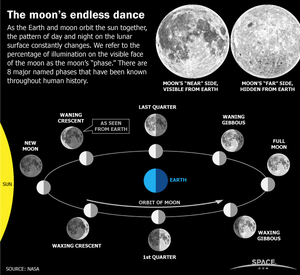Wolf moon
The full moon of January 2017 is blazing brightly in the skies tonight (Jan. 11).
The moon technically reaches its full phase tomorrow morning (Jan. 12) at 6:34 a.m. EST (1134 GMT), but skywatchers can get an eyeful of an apparently full lunar orb both tonight and tomorrow night. The Slooh Community Observatory will air a live webcast about the January full moon at Slooh.com this evening at 8:30 p.m. EST (0130 on Thursday).
You can also watch the moon webcast here on Space.com, courtesy of Slooh. [The Full Moon: Why It Happens (Video)]

See the moon phases, and the difference between a waxing and waning crescent or gibbous moon, in this Space.com infographic about the lunar cycle each month. See the full infographic.
Credit: Karl Tate, SPACE.com
All of the year's full moons have names, which were given to them by Native American tribes living in the eastern and northern United States. January's full moon is known primarily as the "Wolf Moon," according to the Farmers' Almanac:
"Amid the cold and deep snows of midwinter, the wolf packs howled hungrily outside Indian villages. Thus, the name for January’s full moon. Sometimes it was also referred to as the Old Moon, or the Moon After Yule. Some called it the Full Snow Moon, but most tribes applied that name to the next moon."
In the Southern Hemisphere, the January full moon is known as the Hay Moon, Buck Moon, Thunder Moon or Mead Moon, according to Earthsky.org.
A full moon occurs about every month (every 29.53 days, to be precise), when the Earth, moon and sun line up, with Earth in the middle. In this configuration, the lunar near side — the only face skywatchers ever see, because Earth and the moon are tidally locked — is fully illuminated.
Lunar eclipses can occur only when the moon is full. Solar eclipses, on the other hand, happen only during the moon's "new" phase, when the moon gets between the sun and Earth. (The moon's orbit is tilted 5 degrees relative to that of Earth; if the two bodies orbited in exactly the same plane, lunar and solar eclipses would happen every month.)
You can see many details of the lunar surface even without binoculars or a telescope. Large dark regions known as maria, for example, are easily visible to the unaided eye. These are vast plains of basaltic rock, the cooled remnants of ancient lava flows. Their name means "seas" in Latin; early astronomers thought they were huge reservoirs of liquid water.
Editor's note: If you snap an awesome photo of the moon that you'd like to share with Space.com and our news partners for a potential story or gallery, send images and comments in to managing editor Tariq Malik at
Comments
Post a Comment